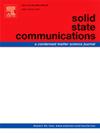Ga2O3 多晶体热导率的理论研究
IF 2.4
4区 物理与天体物理
Q3 PHYSICS, CONDENSED MATTER
引用次数: 0
摘要
氧化镓(Ga2O3)是一种前景广阔的保温隔热材料,了解其热学特性对提高其技术应用性能非常重要。本文采用第一原理技术,通过玻尔兹曼声子输运方程(BTE)计算了标为α、β、δ和ε的氧化镓多晶体的热导率。利用基于广义梯度近似(GGA)的二阶和三阶原子间力常数(IFCs)、声子色散关系、投影态密度(PDOS)和声子群速度,推导出了 Ga2O3 在 50 K 至 1000 K 温度范围内的晶格导热张量 k。结果与斜方多晶体 β-Ga2O3 的实验值以及之前计算的其他相的结果一致。在室温下,δ-Ga2O3 相的预测热导率为 15.6 W/(m-K)。通过将 k 分解为模式贡献,可以推算出由于特殊的声子色散关系,光学声子对晶格热导率的贡献很大。本文章由计算机程序翻译,如有差异,请以英文原文为准。
Theoretical investigation of the thermal conductivity of Ga2O3 polymorphs
Gallium oxide (Ga2O3) is a promising thermal preserving and heat-insulating material; understanding the thermal properties is important to improve its performance in technological applications. The thermal conductivities of Ga2O3 polymorphs labeled as α, β, δ, and ε are computed via the Boltzmann phonon transport equation (BTE) employing first-principles techniques. The lattice thermal conductivity tensor k of Ga2O3 for temperatures ranging from 50 K to 1000 K is derived using the second and third-order interatomic force constants (IFCs) for the potential based on a generalized gradient approximation (GGA), as well as the phonon dispersion relation, projected density of states (PDOS), and phonon group velocities. The results agree with the observed experimental values of rhombohedral polymorph β-Ga2O3 and with the previously calculated results of the other phases. At room temperature, the predicted thermal conductivity of the δ-Ga2O3 phase is 15.6 W/(m•K). By breaking down k into mode contributions, it is projected that the optical phonons contribute significantly to the lattice thermal conductivity because of a peculiar phonon dispersion relation.
求助全文
通过发布文献求助,成功后即可免费获取论文全文。
去求助
来源期刊

Solid State Communications
物理-物理:凝聚态物理
CiteScore
3.40
自引率
4.80%
发文量
287
审稿时长
51 days
期刊介绍:
Solid State Communications is an international medium for the publication of short communications and original research articles on significant developments in condensed matter science, giving scientists immediate access to important, recently completed work. The journal publishes original experimental and theoretical research on the physical and chemical properties of solids and other condensed systems and also on their preparation. The submission of manuscripts reporting research on the basic physics of materials science and devices, as well as of state-of-the-art microstructures and nanostructures, is encouraged.
A coherent quantitative treatment emphasizing new physics is expected rather than a simple accumulation of experimental data. Consistent with these aims, the short communications should be kept concise and short, usually not longer than six printed pages. The number of figures and tables should also be kept to a minimum. Solid State Communications now also welcomes original research articles without length restrictions.
The Fast-Track section of Solid State Communications is the venue for very rapid publication of short communications on significant developments in condensed matter science. The goal is to offer the broad condensed matter community quick and immediate access to publish recently completed papers in research areas that are rapidly evolving and in which there are developments with great potential impact.
 求助内容:
求助内容: 应助结果提醒方式:
应助结果提醒方式:


